WHAT GARDENERS WANTED
In a recent column, I wrote about some of this year’s top takeaways by 17 independent garden centre owners who I surveyed this fall. Here’s more from those conversations:
INFLATION AFFECTS EVERYONE
Everyone is feeling the impact of inflation – both consumers and retailers. Prices are higher and our wallets are stretched. Consumers are being thoughtful about their purchases, and so are retailers who are thinking outside of the box to deliver the types of products their customers want.
“For 2024, tried and tested is our go-to due to inflation and just having less money to play around with,” said Deanne Walstrom, general operations manager, Shelmerdine Garden Centre, Winnipeg.
“Our customers want to know they will be successful and happy with their purchases. We are focusing on what we know works in our Manitoba weather/seasons.”
Lori van der Meer at the van der Meer Garden Centre in Ile des Chenes, noticed that consumers were choosing less expensive grasses this year.
“People are making some moderate adjustments,” she said. “Papyrus King Tut and banana plants, which are more expensive products, did not do as well this year as Dracaena spikes.”
Customers were shopping for more affordable options that would give a similar effect in their outdoor displays, she said.
“The cost of everything – plastic (containers), soils, the cost of labour – is higher, and that impacts the pricing in the greenhouse,” said Erna Wiebe at the Oakridge Garden Centre in Steinbach.
Wiebe noticed that consumers were more likely to choose single potted plants versus bedding plants in cell packs. She speculated that perhaps this is because plants in single pots are bigger and showier than bedding plants in cell packs.
CHOOSING SEEDS OVER PLANTS
Seeds are the answer, said Dave Hanson at Sage Garden Greenhouses in Winnipeg. “I’ve been in the business for 25 years and this was the first year that I really felt that inflation and the cost of living were very tangible barriers to people making decisions.

Inflation has pushed people to embrace growing flowers and vegetables from seed this year, and have done so with success. (Sophia Munro photo)
“Customers were looking for really savvy ways to be smart about how they garden. Seeds deliver a lot of value. People really embraced growing flowers and veggies from seed this year and they had really good success.
“You can grow anything with seeds and that I think, is key. It doesn’t matter where you live – an apartment, condo, or house – you can grow plants. Growing from seed makes gardening accessible to everyone.”
GROWING YOUR OWN INGREDIENTS
Plants that are both ornamental and edible attracted customers, said Maryann Sumka at Sumka Brothers Greenhouses in Winnipeg. Combining herbs with flowers is a great way to attract pollinators and makes your garden multifunctional, she said. But gardeners also want gardening to be fun and easy.
“We offered carrot boxes and beet boxes that are basically window boxes that can go anywhere – on your balcony or patio. We make them ready-to-go and customers snapped them up.”
Jeanne Elliott, co-owner of Ron Paul Garden Centre in Winnipeg, said that growing our own ingredients has become very important.
“Growing something that tastes good, smells nice, and can be added to recipes gives people great joy.”
DROUGHT TOLERANCE GAINS IMPORTANCE
Many of the garden centre retailers said that consumers wanted plants that are drought tolerant. “This comes up frequently,” said Wiebe.
“More and more people are asking for plants that do not require a lot of water.”
BIGGER CONTAINER PLANTERS
“Container gardening keeps getting bigger and bigger,” said Jordan Hiebert at Lacoste Garden Centre. “Planters have become a piece of furniture in the outdoor room that frames the plants.

What gardeners wanted in 2023 were bigger containers with more impact. (Cory Messel photo)
“(Container gardening) used to be about the plants and they might be in a nondescript container. But now people want bigger planters – statement pieces – that have more impact. It might be a big fishbowl planter – 30 inches/76.2cm – or several in the garden that you can see from the deck.”
Dorinda Penner at the Sunshine Garden Centre in Steinbach says that the industry as a whole is seeing more interest in container gardening. She is seeing emphasis on plant combinations.
“What are the best plants that you can pair together in a container? Customers are passionate about finding the prettiest combo. They want flowers and interesting foliage but also structure. They are mixing in veggies and herbs. A mixed container on your deck makes ingredients accessible without a lot of work.”
INDOOR PLANTS ALSO LARGER
Large indoor plants are becoming more popular.
“Two years ago, at the height of the houseplant craze, small 6-inch planters were popular and now demand is shifting to the larger 10-inch, 14-inch, 16-inch indoor planters that are impactful and tie the indoors with the outdoors,” said Hiebert.
“Low-light plants are very important to consumers,” said Hiebert. “Sansevieria and Chinese evergreen (Aglaonema) are very popular.”
Demand is strong for big and fresh tropical plants direct from Florida, said Bernie Whetter, The Green Spot Home & Garden, in Brandon.
“Boston ferns, sansevieria, hoya, pothos, philodendron, cactus, succulents – these varieties are popular and easy to look after. Pothos is one of our most popular houseplants.”
SHADE AND FALL COLOUR FROM TREES
A whole new generation of gardeners are buying trees.
“We are really excited about new, young homeowners who want to plant trees,” said Wiebe. “They understand that we need to shade our houses, cool down our planet, and put some green in the landscape.”
In addition to the desire for cooling shade, customers are looking for trees with beautiful fall colour. But many of us want the same tree variety!
Demand continues to be huge for Autumn Blaze Maple and wholesale growers can’t keep up with demand, said Penner. Ruby Slippers Amur Maple (Acer ginnala) is gaining attention, she said.
Penner predicts that interest will surge for trees with brilliant fall colour. “We’ve had such an autumn for stunning fall colour this year.”
GARDENING FOR DOWNSIZERS
There is new demand from the 55+ community for workshops, said Jeanne DuBois at the Ron Paul Garden Centre in Winnipeg.
“People who are downsizing – making the move to smaller homes, condos, or apartments – are looking for new ways to garden. They love to garden or are new to gardening and they want to know what to grow in a smaller indoor space or on a balcony.”
There is so much you can grow indoors or on a balcony, said DuBois, including tropical plants, herbs, and lettuces.
HARDINESS ZONE UPDATES
In mid-November, the U.S. Department of Agriculture’s plant hardiness zone map was updated for the first time since 2012. The most recent version was prepared by the PRISM Climate Group at Oregon State University and USDA.
The new 2023 map shows about half the U.S. has shifted into a new half zone (for example, zone 4a to 4b).
The 2023 USDA plant hardiness zone map is about 2.5 F / 1.4 C warmer than the 2012 map, according to the PRISM Climate Group.
The first question on the lips of many Canadian gardeners who are also experiencing a warming climate is, when will the Canadian Plant Hardiness Zones Map be updated?
I reached out to Dan McKenney and John Pedlar, research scientists with Natural Resources Canada. Pedlar and McKenney worked together on the Canadian Plant Hardiness Zone Maps, which were last updated in 2014 using climate data from 1981 to 2010.
“We are currently working on an update and are hoping to have it completed within the next year,” said Pedlar.
According to the current Canadian Plant Hardiness Zone Map, Winnipeg is in zone 3b. The challenge to plants rated for warmer zones is winter injury to woody plant material that is exposed above the snow line.
“We know that we have fluctuations in temperature. Our winter patterns can be variable,” explains Shawna Ronald Bell at Jeffries Nurseries in Portage la Prairie. “In our extreme temperatures, winter injury such as dieback can occur to Zone 4a trees or woody shrubs that are not covered in an insulating layer of snow.”
Interestingly, the new USDA plant hardiness zone map continues to rate the northernmost area of North Dakota – directly alongside the Manitoba border as zone 3b.
Many gardeners in southern Manitoba, including myself, successfully grow zone 4a perennials. I also grow some trees and shrubs that are 4a but I’m not always successful, so I do take extra precautions such as planting in a protected site and adding layers of mulch in late fall after the first hard frost.
What has your experience been with growing 4a plants? What do you think is the most accurate zone hardiness rating for Winnipeg? Reply to this email with your thoughts.
LET IT SNOW, LET IT SNOW…
The first snowfall of the season melted before our eyes.
When temperatures plunged well below freezing a few nights in November, there was no insulating blanket of protection.
Will winter burn or evergreen browning be more of a problem if we continue to have minimal snow, combined with a sudden steep drop in temperatures? Is there anything that homeowners can do now? I reached out to Gerry Engel, president of Trees Winnipeg.
“The season has been dry so far and that could have an effect on the conifers come late winter when the heat of the sun increases the respiration of the trees,” he said.
“Most important was to have watered the trees going into winter. Now that the ground has started to freeze there is little one can do to add more moisture.
“Should we get snow, I’d suggest shoveling any snow onto the root zone of trees to both insulate the soil as well as make moisture available once the snow melts.”
“I always encourage people to practice gardening that promotes the building of good soil structure through the use of wood mulches as well as planting a diversity of plants.
“Healthy soil structure has better water infiltration and water holding capacity than soil with degraded structure. Improving soil structure takes time to develop therefore the sooner one starts, the quicker your trees will benefit.”
A GREAT SHADE PLANT
Hosta may be the best-known shade plant, but hellebores are the best kept secret. Hostas and hellebores make great companions.
Helleborus niger is commonly known as the Christmas rose. The Latin name niger means black, which is in reference to the inky colour of the roots.
Hellebores are long-lived shade perennials that have long-lasting flowers (two to three months).
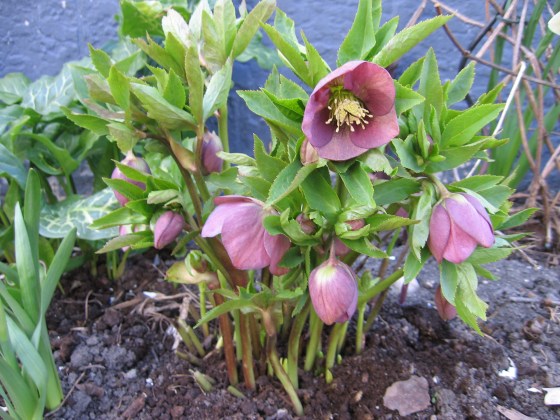
The Christmas Rose and the Lenten Rose make great companions for hostas. (Valerie Denesiuk photo)
A member of the Ranunculaceae (buttercup) family, hellebore plants have dark evergreen, leathery-textured foliage and large, cupped flowers that typically have five overlapping petals surrounding enticing centres with showy stamens.
Helleborus niger is hardy to Zone 4, although some sources rate it as hardy to Zone 3. The best indication of hellebore’s cold hardiness may be the growing number of local gardeners who have been successfully growing hellebores for many years! A protected location and a protective layer of mulch makes all the difference.
Sometimes at this time of year it’s possible to find Helleborus niger Christmas rose plants tucked in amongst other types of holiday plants at local garden centres.
If you are fortunate to find one, place it in the coolest room of your house with an east- or west-facing window where it will receive only indirect light. While it is in flower, feed it with a half-dilute fertilizer.
In spring, when the risk of frost has passed, plant your hellebore outdoors in a location that receives some morning sun but protection from any afternoon sun. Hellebores prefer well-drained soil that is amended annually with a topdressing of organic matter.
There is also Helleborus x hybridus which is commonly known as the Lenten rose. These evergreen perennials have nodding flowers that bloom in early spring. There are many colourful varieties to choose from.
ALL-AMERICAN SELECTIONS WINNERS FOR 2024
AAS Winners for 2024 were announced in November, except for Marigold Siam Gold which was announced in July. All AAS Winners are trialed throughout North America by professional, independent volunteer judges.
The All-America Selections Winners for 2024 are:
- Broccoli Purple Magic F1
- Broccoli Skytree F1
- Celosia Burning Embers
- Geranium Interspecific Big EEZE Pink Batik
- Impatiens Interspecific Solarscape XL Pink Jewel
- Marigold Siam Gold
- Pepper Red Impact F1
- Petchoa EnViva Pink (cross between Calibrachoa and Petunia)
- Petunia SureShot White
Sometimes it can take a while before new AAS Winners show up at local garden centres. But of the new AAS varieties for 2024, we can be confident that we will see the following next spring:
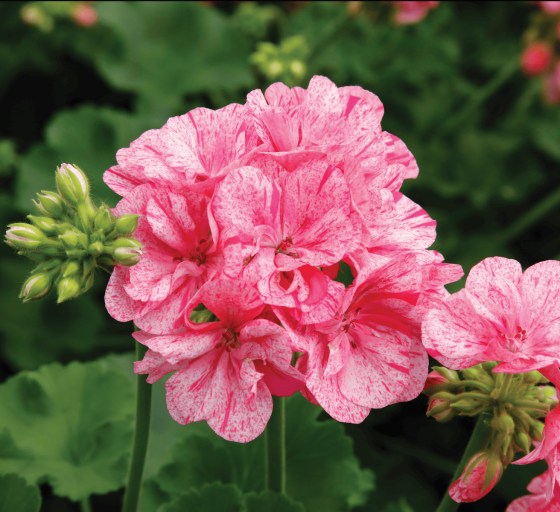
Geranium Interspecific Big EEZE Pink Batik is one of the All-America Selections winners for 2024. (Supplied)
Geranium Interspecific Big EEZE Pink Batik has beautiful pink bicolour. It is an interspecific geranium, which means that it combines the best traits of zonal and ivy geraniums. Interspecific geraniums are bred for greater heat and drought tolerance.
Petchoa EnViva Pink is a cross between calibrachoa and petunia. EnViva Pink has a bright pink flower with a yellow throat. I trialed Petchoa EnViva in my garden last summer – the flowers have real staying power!
Impatiens Interspecific Solarscape XL Pink Jewel boasts very high disease resistance and large showy flowers that bloom non-stop from spring through fall. Best of all, Impatiens Solarscape can be grown in sun or shade.
It’s extraordinary to see how well Impatiens Solarscape withstands strong wind or heavy rain. I wouldn’t be without this impressive annual.
While Solarscape XL Pink Jewel will not initially be available in seed form for consumer purchases, older cultivars in the Solarscape series can be grown from seed. Petunia SureShot White has a mounded, trailing habit and produces a cascade of pure white blooms all summer long.
Full details about AAS Winners can be found on their website.
WHAT DOES F1 HYBRID MEAN?
Did you notice that three of the AAS Winners for 2024 have “F1” after their names? Often, we see this designation on plant tags for vegetable and ornamental varieties.
F1 means first generation child. F1 hybrids are produced by crossing two distinct varieties that are genetically uniform. The parent plants descend from pure lines.
One advantage is that the F1 hybrids typically exhibit improved characteristics, for example, increased yield, higher disease resistance, uniform appearance, etc.
But F1 hybrids may not produce seeds —or if they do, the offspring plants that are produced will not be identical to the parent. Indeed, the sibling plants will all look different from one another.
NEW HYDRANGEA
Dragon Baby Hardy Hydrangea is a new dwarf hydrangea from Bloomin’ Easy. In August, it earned a coveted Retailer’s Choice Award at the Farwest Show, one of the biggest trade shows in the North American green industry.
Dragon Baby is a hardy panicle hydrangea that grows to a height of 2-3 feet (60.96-91.44cm). It has large, fat blooms on sturdy stems. I’m dreaming of spicing up the front of a so-so border in my garden with multiples of Dragon Baby for season-long colour and blooms.
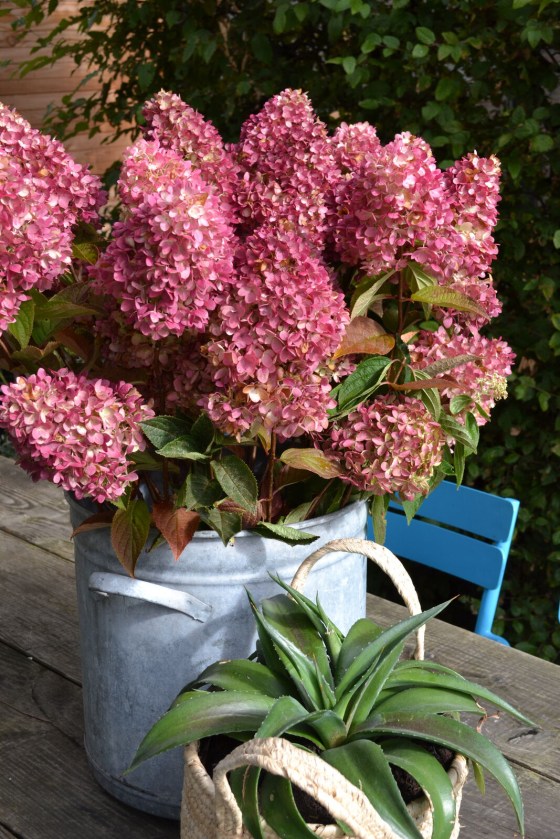
Dragon Baby Hardy Hydrangea grows to a height of 2-3 feet. (Bloomin’ Easy)
Garth Aubin, Aubin Nurseries, a wholesale nursery in Carmen, recently told me that Dragon Baby Hydrangea has performed quite nicely with good growth habit in plant trials at Aubin’s.
“The blooms are so plentiful and it goes a very nice pink in the fall,” he said.
Aubin also said that Dragon Baby Hydrangea should be available at local garden centres by next summer. Yeah, Baby!
COMPOST PICKUP
Want to make your holiday party more sustainable? Compost!
Compost Winnipeg invites you to set aside your food scraps and compostable cutlery and dishes for a compost pickup.
Contact Compost Winnipeg at 431-317-5254 or 204-232-0025 or email info@compostwinnipeg.ca for more info and to book a compost pickup.
KEEP LIVE DECORATIONS FRESH
“This has been a first in all the 15 years I have been in business building outdoor planters that weather has been so mild,” says Sharlene Nielsen, owner of Front Door Stories.
Nielsen says that keeping fresh outdoor decorations hydrated will be crucial, especially for seasonal planter displays that are situated in full sun.
“Water, water and more water,” she says. “We typically water planters when we first build our designs along with fresh cuts to each stem.”
The freeze-thaw process that occurs at this time of year can have a drying effect on fresh greenery. Watering and misting are essential for both fresh outdoor and indoor greenery, says Nielsen.
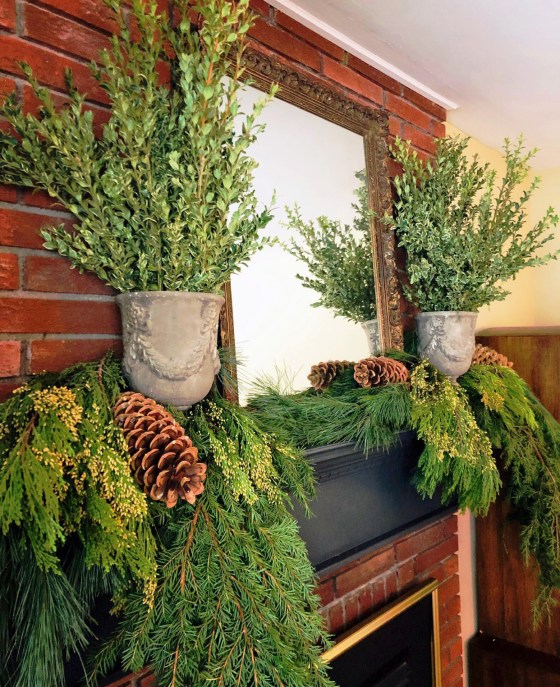
Keep your fresh holiday greenery hydrated. (Sharlene Nielsen photo)
If you are not using indoor greenery right away, Nielsen recommends that you place it in a plastic bag away from direct sunlight. Mist before closing the bag and store in a very cold location until needed, she says.
“Keep your greenery in a cold space until the last minute so it lasts longer and your home smells fresh for guests. When you are ready to use the greenery, keep your misting bottle handy and mist daily!”
Fresh-cut greens in water last longer, says Nielsen. Change the water every two to three days.
For indoor use, live greenery such as cedar and pine have less needle drop, says Nielsen. “Pine is very sappy so lining surfaces with clear plastic will help prevent a sticky mess,” says Nielsen.
Front Door Stories is hosting an Open House December 7th to 10th . The botanical boutique studio is located at 208 Browning Blvd. For more details, visit their website.
HOLIDAY DECORATING ON A BUDGET
Karen Chopp, aka the barefoot gardener, is also busy designing outdoor seasonal planters for clients and has these recommendations:
Foraging, foraging, foraging: Mother Nature has some really great natural baubles – seed pods, twigs, pinecones, fallen branches – that can be tucked into greens for a beautiful pot.
If you harvest dogwood or willow branches, harvest quite a bit and use a large clump to create density. Dried hydrangea flowerheads in the winter garden add wonderful gold and bronze accents to seasonal planters.
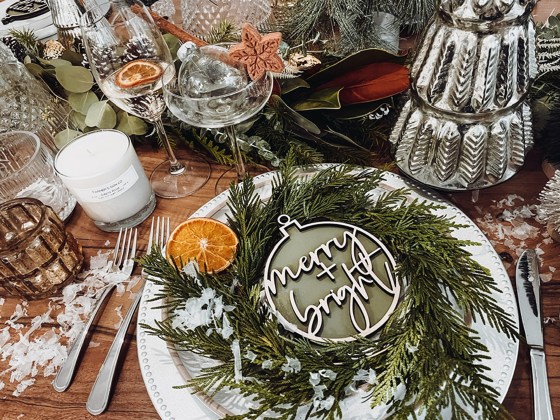
Styling the holiday table with fresh greenery. (Bubbles and Bash)
Use what you already have. If your indoor faux garland looks a bit tired, revitalize it with a wire wreath frame (available at dollar stores). Using your faux garland as a base, add an assortment of fresh greens, twigs, and cones.
Black zip ties are a decorator’s secret weapon! They are perfect for securing items to wreaths, garlands, and trees, as well as for hanging wreaths and creating twig bunches. Ribbon bows that you saved from gift baskets can also be added to your wreath.
When purchasing faux items like holiday garlands and wreaths, I always buy the fullest style that I can afford and choose a mixed garland to which I can add single stem picks that have different kinds of greens.
I love shopping at craft/décor stores and finding unique garlands or large stems that can be cut apart so that the different elements can be used separately. This can be a bit pricier to start with, but once you start cutting the garland apart, you can use the components to use the components to help stretch your decorating budget.
Save your faux items from year to year. If you are buying a ready-made planter, plan to save those birch logs and cones for next year!
Tomato cages make great cone shapes. Just turn them upside down and wrap mini lights around them. Garden trellises work, too.
Shop for deals in the off season. Take advantage of sales on dried florals in summer or fall at décor stores.

Providing shade for outdoor live decor helps it to last longer. (Karen Chopp photo)
Chopp recommends the use of branches and cones as a focal point if your outdoor holiday container sits in full sun. Faux greenery will allow you to leave your planter in place for a longer time without browning, she says.
“Water your planters when temperatures are above zero and move your planter to the least sunny side of your entrance door. Shade is helpful.”
Fluffing up faux garlands, wreaths, and trees, and shaping and spreading out branches like you see in nature, takes a little time, but the effect is worth it, says Chopp.
“The more lights the better,” says Chopp who loves the combination of branches with warm white mini lights.
KEEP YOUR CHRISTMAS TREE FRESH
Susan Jensen, co-owner of Jensen’s Nursery shares these simple tips for keeping a Christmas tree fresh and reducing needle drop:
• Make a fresh cut by removing at least one inch (2.5 cm) from the bottom of the tree stump.
• Place the tree into a tree stand and add water within 30 minutes of bringing it home.
• Check the water level two or three times each day. Never allow the water level to drop below the bottom of the stump. If the water level drops below that point, the sap in the tree will reseal the cut end and your tree will no longer be able to take up water.
Jensen recommends Cinco Express Stands. “They are strong and have very large water reservoirs.”
POINSETTIA KOKEDAMA
Kokedama means moss ball. This unique art form traces its early beginnings to 17th century Japan.
To make your moss ball, start with a small poinsettia or any small plant of your choice – Christmas cactus (Schlumbergera), sedum, kalanchoe, African Violet, fern, or a small tropical houseplant.
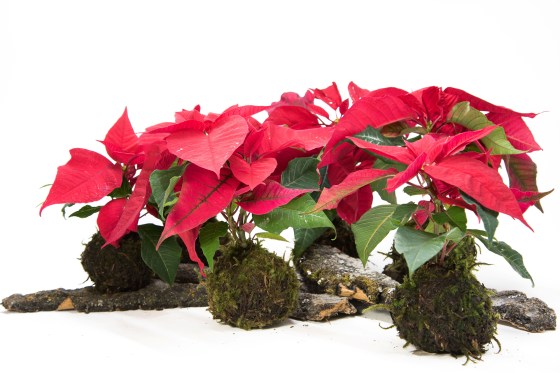
Make your own poinsettia kokedama (Caine Chow photo)
You will need sphagnum moss, peat moss, sheet moss, bonsai soil mix, thin twine, clean scissors, and a bowl of fresh, room temperature water. Bonsai soil mix is available at local garden centres.
Begin by removing your plant from its pot and gently remove most of the soil around the plant’s roots. Snip off long, straggly roots, leaving just the thin white roots.
Pamela McFarlane is a member of the St. James Horticultural Society’s flower arranging group. “Combine 7 parts peat moss and 3 parts bonsai soil and add just enough water until you can make a ball shape that is about the size of an orange,” says McFarlane.
Firm the soil but don’t compact it. Next, separate your soil ball in two halves.
“Wrap the roots of your plant in sphagnum moss, secure gently with twine, and place between the two halves of your soil ball.”
The next step is to wrap your soil ball with pre-soaked sheet moss.
“Wrap the finished ball with twine and spray your kokedama with water,” says McFarlane.
If your home’s temperature is warm and misting does not provide enough moisture for your plant, you can immerse the bottom half of your moss ball in room temperature water just long enough for it absorb water.
COLOUR OF THE YEAR
Communities in Bloom’s program helps communities to focus on green infrastructure to help adapt to and mitigate the impacts of climate change, connecting people to nature, contributing to healthier communities, and strengthening and conserving natural, built, and cultural heritage.
The National Communities in Bloom organization, in honour of Truth and Reconciliation, has selected orange as the 2024 flower colour of the year.
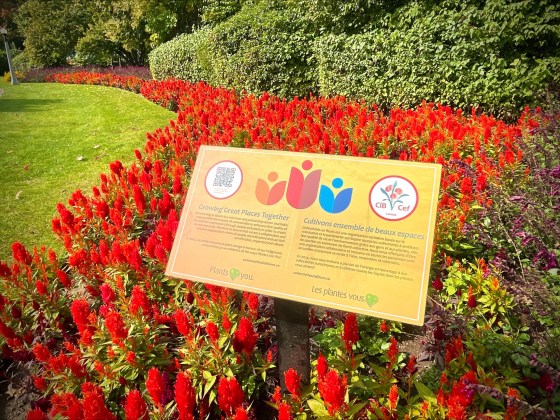
Get ready for a sea of orange flowers in 2024.
“I really enjoy waiting for the National team to surprise us with the colour for each year,” says Shirley Kalyniuk, president of the organization’s Manitoba chapter.
“With all the recent news articles and everyone working as a team through the reconciliation process, it is very fitting to select orange as the colour for 2024. I am very excited to see many gardens, flowerpots, and containers with a beautiful splash of all shades of the colour orange.”
GREAT GARDENING READS
The 2024 Prairie Garden “Year-Round Gardening” – Published annually in Winnipeg by a volunteer committee, The Prairie Garden is Western Canada’s only gardening annual.
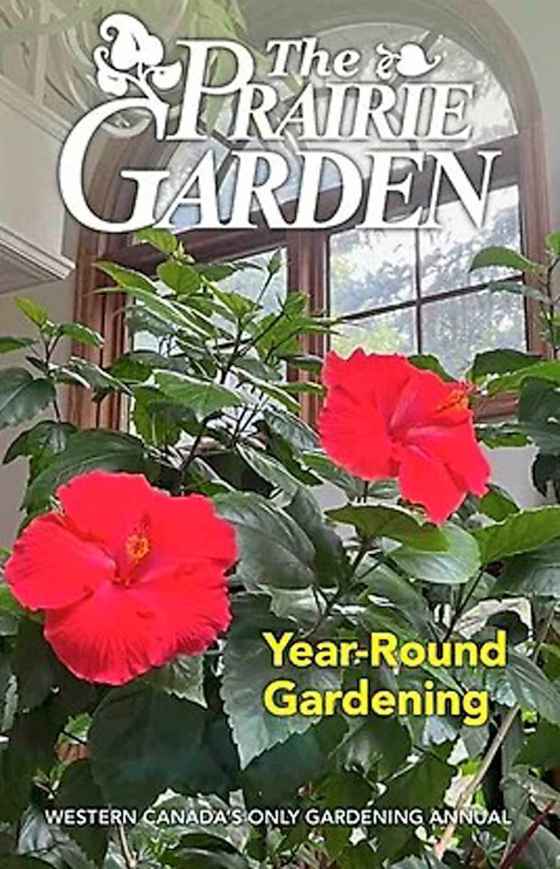
Published annually in Winnipeg by a volunteer committee, The Prairie Garden is Western Canada’s only gardening annual.
This stellar 85th edition, with guest editor Barb Shields, takes a comprehensive look at everything you need to know about growing plants year-round and features over 50 articles written by contributors from across the Northern Great Plains.
The Prairie Garden is an annual favourite that covers all aspects of gardening and horticulture. Available in paperback at most garden centres and bookstores in Manitoba for $20.
The Cottage Garden by Claus Dalby (Cool Springs Press, 2023) – Danish celebrity gardener Claus Dalby explores the history and development of the cottage style of gardening.
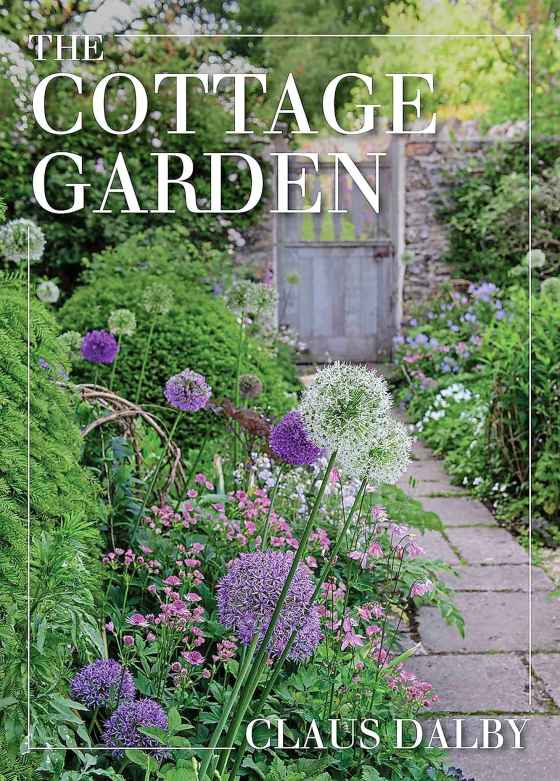
Danish celebrity gardener Claus Dalby explores the history and development of the cottage style of gardening.
From insights to famous cottage gardeners such as Gertrude Jekyll and William Robinson to modern-day cottage gardeners who create dreamy landscapes with flowers that anyone can grow, The Cottage Garden is an inspiring guide that includes over 700 stunning photographs.
But it’s not only the flower gardens that will enthrall you – Dalby invites you to look further at how classic wooden structures and unique décor will take your outdoor garden room, big or small, to another level. The Cottage Garden is available in hardcover at McNally Robinson Grant Park for $53.
The Complete Book of Ground Covers: 4000 Plants that Reduce Maintenance, Control Erosion, and Beautify the Landscape by Gary Lewis (Timber Press, 2022) – Author Gary Lewis, who is also the owner of Phoenix Perennials, a mail order nursery in Richmond, B.C., has written the quintessential guide to ground covers, from A to Z.
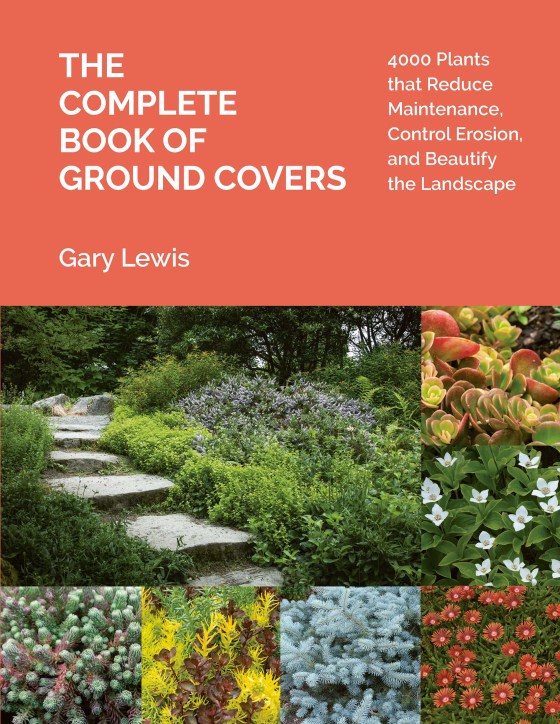
The Complete Book of Ground Covers by Gary Lewis, published by Timber Press.
Lewis has traveled around the world and the majority of the book’s photos are his.
The Complete Book of Ground Covers is relatable and easy to read. But more than that, readers will find design tips and different uses for ground covers — including container gardens. This encyclopedic reference weighs 1.74 kg – (almost) light enough to carry with you when you are shopping for plants. Available in hardcover at McNally Robinson or online through Chapters Indigo for $63.
ONE MORE REASON TO “LEAVE THE LEAVES”
Plastic waste is a global problem. An enzyme that was discovered in a pile of rotting leaves a decade ago may be key to solving the problem.
Leaf and branch compost cutinase helps microbes break down the waxy coating of leaves. Promising research is now being done at the University of Toulouse in France that could see the enzyme play a powerful role in recycling huge amounts of plastic that would otherwise go to landfills.
You can read more about this evolving story on the website Science, a website by the American Association for the Advancement of Science.
WORD OF THE YEAR
Merriam-Webster’s Word of the Year for 2023 is “authentic,” which means real, bona fide, genuine.
More and more we are hearing the word “authentic” in relation to garden design but what exactly does that mean? Using natural and organic materials to give your garden a more natural look? Planting only native plants? Adherence to the principal of right plant, right place?
Being authentic also means being true to one’s own personality. Our own garden and how and why we create it is about as personal as it gets.
What does authenticity in the garden mean to you? Reply to this email with your thoughts.
MARK YOUR CALENDARS
World Soil Day is held annually on Dec. 5 to focus global attention on the importance of healthy soil and advocating for the sustainable management of soil resources. Healthy soil means healthier plants and more nutritious homegrown fruits and veggies.
On Thursday, December 7, 1:30 p.m. to 2:30 p.m., Martha Barwinsky, city forester, City of Winnipeg, is presenting a free online lecture for the Canadian Institute of Forestry and Tree Canada. The presentation is called Equity: Considerations in Urban Forest Management – A Winnipeg Perspective. Registration is open to all here.
The world renowned floral show Fleurs de Villes is coming to Winnipeg for the first time! It’ll be at The Leaf at Assiniboine Park, Jan 11 to 21. For tickets, visit The Leaf.
Back by popular demand! On February 3, 2024, at Cinematheque, 300 Arthur Street, Manitoba Master Gardener Association and Manitoba Horticultural Association are co-hosting a second screening of the award-winning documentary Planet Soil. More details coming soon!
|

